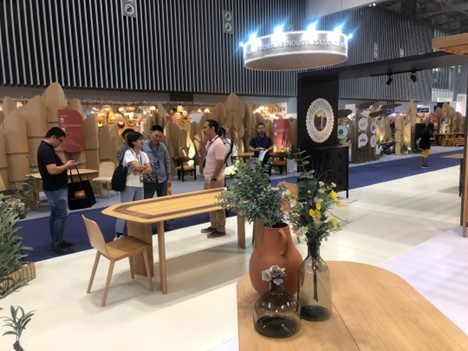Vietnam Furniture Market 2024: Potential but Not Without Challenges
- 599
- Business
- 18:21 05/02/2024
DNHN - In 2024, the Vietnamese furniture market is expected to continue its robust growth, driven by several favourable factors such as the middle class’s demand for improved living spaces, urbanisation, and the tourism industry’s expansion.
According to a report by market research firm Mordor Intelligence, the size of Vietnam’s furniture market is projected to increase from USD 1.40 billion in 2023 to USD 1.82 billion by 2028, exhibiting a CAGR of 5.33% during the forecast period (2023-2028).

In this regard, data from the General Statistics Office shows that Vietnam’s GDP in 2023 reached 6.5%, exceeding the World Bank’s (6.2%) and the International Monetary Fund’s (6.3%) forecasts. The average income per capita in 2023 was USD 3,700, a 7.1% increase compared to 2022.
The middle class’s growing demand for housing and improved living spaces is driving the furniture market. According to a World Bank report, Vietnam’s middle class has doubled in the past decade, from 12% of the population in 2010 to 26% in 2020. The Vietnamese middle class, with an income ranging from VND 10 million to VND 20 million per month, accounts for 13% of the population and tends to purchase more premium products, including furniture. Rapid urbanisation has led to a significant demand for furniture in apartments and townhouses.
According to the Ministry of Planning and Investment, Vietnam’s urbanisation rate in 2023 reached 40.6%, an increase of 0.9% compared to 2022. The number of apartment projects granted construction permits in 2023 reached 1,000, a 10% increase compared to 2022. The demand for furniture in apartments is projected to increase by 15% in 2024.
The thriving tourism industry has resulted in a high demand for furniture in hotels and resorts. According to the General Department of Tourism, the number of international visitors to Vietnam in 2023 reached 18 million, a 15% increase compared to 2022. Domestic tourists in 2023 reached 85 million, a 12% increase compared to 2022. Hotels and resorts need to invest in upgrading and decorating their interiors to attract customers.

Vietnam’s furniture market not only faces competition from domestic businesses but also from foreign companies, particularly from China, Thailand, and Malaysia. Foreign companies have advantages in terms of price, design, quality, and service. According to the Vietnam Timber and Forest Products Association, in 2023, Vietnam’s furniture import turnover reached USD 3.5 billion, a 20% increase compared to 2022. Of these, China accounted for 60%, Thailand accounted for 15%, and Malaysia accounted for 10%.
Mr Nguyen Ngoc Phuong, CEO of ARC Company, shared that the Vietnamese furniture market has significant growth potential. Vietnam’s economy is growing well, people’s incomes are increasing, and the demand for furniture is also increasing. However, the Vietnamese furniture industry is facing many challenges: fierce competition, a shortage of human resources, and inconsistent product quality. To succeed in the furniture market, businesses need to improve product quality, enhance customer service, and build a strong brand. ARC Company always pursues the goal of becoming a leading furniture brand in Vietnam and the region.
The Vietnamese furniture industry is facing a shortage of quality human resources, especially skilled workers, design personnel, and management staff. According to the Vietnam Timber and Forest Products Association, in 2023, the Vietnamese furniture industry needed about 500,000 workers, but only 300,000 workers met the requirements. Of these, only 10% of workers are skilled, 5% of workers are capable of designing, and 3% of workers are capable of management.
On the other hand, the crucial factor in building customers’ prestige and trust is product quality. Businesses need to ensure product quality from raw materials, design, production, packaging, transportation, installation, and warranty. Furniture products need to meet the criteria of durability, safety, aesthetics, convenience, and environmental friendliness.
Simultaneously, businesses need to provide professional, dedicated, and flexible customer services, such as consultation, design, installation, warranty, maintenance, return, and technical support. Businesses need to listen, understand, meet, and exceed customer expectations.
To create differentiation and competitiveness for businesses, they need to build a strong brand by creating furniture products with added value, creativity, and a unique style. Businesses need to implement effective communication, promotion, and marketing strategies, targeting the target customer group, and enhancing brand recognition and trust. The Vietnamese furniture market in 2024 is predicted to continue its robust growth with significant growth potential.
Quang Duy – Van Nguyen
Related news
- Connecting Leaders, Shaping the Future: Strategic Leadership Planning Meeting – CorporateConnections Hanoi A
- Sunlight - Unilever Vietnam Recognized for Outstanding Contributions to the National Initiative Supporting Women Entrepreneurs
- Deputy Prime Minister Nguyễn Chí Dũng: “The country’s major challenges weigh heavily on my mind — and we must resolve them together.
- Unitsky String Technologies signs cooperation agreements with three Vietnamese partners, opening a new direction for smart mobility and sustainable development
- When artists do business – livelihood is no poetry!
- Before the D‑day to abolish flat‑rate tax: Fear of technology and costs leave small traders struggling to adapt
- Vietnamese enterprises at a crossroads: the impact of a potential US–China deal
- "Digital technicians" must not be forgotten if Vietnam aims to meet its strategic goals
- HDBank: Impressive profit growth, leading in profitability and advancing international integration
- TNI King Coffee sued for over VND 5 Billion in unpaid debts
- VINASME and Jeonnam Technopark Sign MOU on technology cooperation, human resource training, and trade promotion
- Vietnamese entrepreneurs strengthen ASEAN connectivity in the digital iIntegration era
- Prime Minister: Vietnam aims to become a regional logistics hub
- Vietnam upgraded to Secondary Emerging Market by FTSE Russell
- Hanoi’s economy grows 7.92% in first nine months of 2025, FDI surges nearly threefold
- Vietnam’s strong gdp growth fails to ease labor market distress
- US tariffs on Brazil propel Vietnam’s pangasius into global spotlight
- VietLeap AI Accelerator launches: A strategic springboard for Vietnam’s AI startups
- CICON expands strategic alliances: A new step forward in Vietnam–Korea business connectivity
- What must Vietnamese enterprises do to maintain their position in the global supply chain?
Đọc thêm Business
Connecting Leaders, Shaping the Future: Strategic Leadership Planning Meeting – CorporateConnections Hanoi A
"Your network is your most powerful flowing asset. It generates value, multiplies opportunities, and accelerates your influence across borders."
Innovative ESG enterprise: Trạm Xe Việt startup proposes solutions to build a green mobility ecosystem
As Vietnam commits to achieving Net Zero by 2050 and tightens emissions standards, the transportation sector faces unprecedented pressure to transform.
Deputy Prime Minister Nguyễn Chí Dũng: “The country’s major challenges weigh heavily on my mind — and we must resolve them together.
On the morning of November 26, 2025, Deputy Prime Minister Nguyễn Chí Dũng chaired a high-level working session at the National Innovation Center (NIC) in Hòa Lạc.
Unitsky String Technologies signs cooperation agreements with three Vietnamese partners, opening a new direction for smart mobility and sustainable development
The signing ceremony took place in Minsk, Belarus, on November 28, 2025.
Before the D‑day to abolish flat‑rate tax: Fear of technology and costs leave small traders struggling to adapt
From 1 January 2026 the flat‑rate tax regime will be abolished. Small business households will be required to declare tax based on actual revenue. MISA supports the transition with technology to help micro‑merchants adapt smoothly and transparently.
Vietnamese enterprises at a crossroads: the impact of a potential US–China deal
As the world closely monitors every shift in US-China relations, emerging signals of a strategic agreement between the two global powers are raising hopes for global economic stability.
HDBank: Impressive profit growth, leading in profitability and advancing international integration
Ho Chi Minh City Development Joint Stock Commercial Bank (HDBank, stock code HDB) announced its consolidated profit before tax for the first 9 months of 2025 reached VND 14,803 billion, marking a 17% increase year-on-year (YoY).
TNI King Coffee sued for over VND 5 Billion in unpaid debts
On October 21, 2025, the People’s Court of District 10 in Ho Chi Minh City officially accepted a civil lawsuit concerning a commercial contract dispute between TKT Vietnam Plastic Packaging Joint Stock Company and TNI King Coffee Co., Ltd.
VINASME and Jeonnam Technopark Sign MOU on technology cooperation, human resource training, and trade promotion
On October 15, 2025, in Hanoi, VINASME and Jeonnam Technopark (Korea) signed an MOU to promote trade, advance technology transfer, and develop human resources between enterprises of both nations.
Vietnamese entrepreneurs strengthen ASEAN connectivity in the digital iIntegration era
On the occasion of Vietnam Entrepreneurs’ Day (October 13), an international event themed “Integration – Innovation – Sustainable Development” was solemnly held in Ho Chi Minh City.











